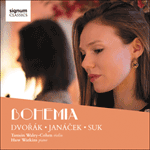The Four Pieces for violin and piano Op 17 were composed in the spring of 1900 and dedicated to Karel Hoffmann, a fellow violinist in the Czech Quartet. The structure of these movements is simple, but their wide-ranging rhetoric proclaims a clearly sophisticated compositional temperament. The first movement, beginning with near-Impressionist colouring, also embraces extravagant romantic gestures in its central section. There is a hint of the national accent in the emphatic cross-rhythms which characterize the outer sections of the Appassionato second movement; these frame a passage of rapt lyricism entirely typical of Suk’s early maturity. This tendency is echoed in the intense opening of the third movement, although once again Suk, somewhat in the manner of alternation favoured by Dvořák in his Dumka movements, mingles seriousness with a brisker style of writing owing something to the Polka. The finale adopts the manner of a perpetuum mobile, drawing in a pastiche of the Classical manner amid the instrumental pyrotechnics.
from notes by Jan Smaczny © 2004
Les Quatre Pièces pour violon et piano opus 17 furent composées au printemps de l’an 1900 et dédicacées à Karel Hoffmann, violoniste du Quatuor Tchèque. La structure de ces mouvements est très simple, mais leur rhétorique développée annonce un talent de compositeur particulièrement sophistiqué. Le premier mouvement commence par des teintes quasi impressionnistes pour se lancer ensuite dans un romantisme débridé dans sa section centrale. On retrouve une trace d’accent national dans les rythmes croisés pleins d’emphase qui caractérisent les sections encadrant le deuxième mouvement Appassionato, et un passage particulièrement lyrique, typique de la maturité naissante de Suk. Cette tendance an contraste se retrouve aussi dans l’ouverture intense du troisième mouvement : une fois de plus, le compositeur mélange le sérieux à un style plus vif, qui n’est pas sans rappeler la Polka, un peu comme Dvořák alternait les styles dans ses Dumka. L’œuvre se termine sur un final qui fait penser au mouvement perpétuel, et qui mélange pastiche du style classique et feux d’artifice instrumentaux.
extrait des notes rédigées par Jan Smaczny © 2004
Français: Marie Luccheta
Die Vier Stücke für Violine und Klavier op. 17 entstanden im Frühling 1900 und sind Karel Hoffmann gewidmet, ebenfalls Geiger im Tschechischen Streichquartett. Die Struktur der Sätze ist simpel, jedoch kündigt ihre weitreichende Rhetorik ein deutlich anspruchsvolles kompositorisches Temperament an. Der erste Satz beginnt mit fast impressionistischen Farben und verarbeitet auch extravagante romantische Gesten im Mittelteil. In den emphatischen Synkopierungen der Rahmenteile des zweiten Satzes, Appassionato, ist fast ein Nationalkolorit herauszuhören. Der Binnenteil ist besonders lyrisch und damit charakteristisch für Suks frühe Reifeperiode. Die Tendenz ist auch in dem intensiven Anfang des dritten Satzes spürbar, obwohl Suk hier wieder das Ernste mit einem forscheren, fast polkahaften Stil kombiniert, nicht unähnlich dem Prinzip der Alternation, das Dvořák in seinen Dumka Sätzen verwendete. Das Finale ist wie ein Perpetuum mobile; zwischen dem instrumentalen Feuerwerk erscheint ein klassisches Pastiche.
aus dem Begleittext von Jan Smaczny © 2004
Deutsch: Viola Scheffel


 Dvořák, Janáček & Suk: Bohemia - Violin Sonatas
Dvořák, Janáček & Suk: Bohemia - Violin Sonatas
